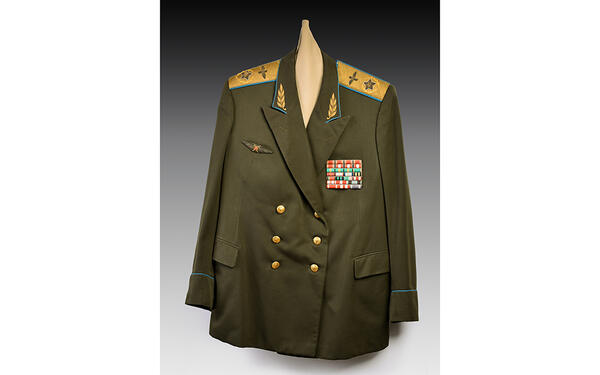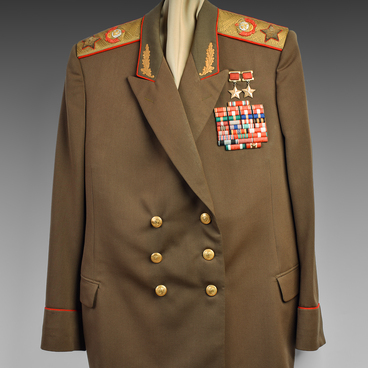The service dress jacket presented in the exposition belonged to the Chief Marshal of Aviation Konstantin Vershinin. In the pre-WWII years, he graduated from the Vystrel high school of command personnel and entered the correspondence department of the Mikhail Frunze Military Academy.
During the Great Patriotic War, Vershinin first commanded the Air Force of the Southern Front, and then the 4th Air Fore Army, which took part in battles from the foothills of the Caucasus to Berlin. In close cooperation with the combined arms and tank armies, the aviation under the command of Vershinin waged an intense fight against the enemy for each defensive line destroying the reserves that approached.
Air battles in the Kuban marked the beginning of the strategic domination of Soviet Air Force in the air and on the entire Soviet-German front. This success was largely the result of Vershinin’s activities. Under his leadership, the 4th Air Force Army, instead of episodic strikes delivered on a wide front, switched to continuous support for infantry and tanks with massive actions of bombers and attack aircraft. Thanks to this, the pace of the offensive of the ground forces increased.
In the most challenging period of the Red Army’s retreat at the beginning of the War, Vershinin in a short time organized the combat operations of the Air Force. He was able to organize both the actions of the flight units and the planning of the combat activities of the rear units, the operation and restoration of the materiel. Vershinin’s army took an active part in the liberation of the Byelorussian SSR and Poland, the battles in East Prussia and the Berlin operation. Vershinin skillfully carried out an air operation to disorganize the enemy’s operational rear by bombing operations, as a result of which a number of strategic railway junctions were destroyed, and the enemy suffered significant losses in the areas where his retreating troops were concentrated. In addition, Vershinin established the work of air reconnaissance, which provided the command of the front and ground armies with timely and reliable data on the position of enemy troops.
After the Great Patriotic War, Vershinin continued to work on the development and improvement of the Soviet Air Force. Moreover, he stood at the origins of cosmonautics.
During the Great Patriotic War, Vershinin first commanded the Air Force of the Southern Front, and then the 4th Air Fore Army, which took part in battles from the foothills of the Caucasus to Berlin. In close cooperation with the combined arms and tank armies, the aviation under the command of Vershinin waged an intense fight against the enemy for each defensive line destroying the reserves that approached.
Air battles in the Kuban marked the beginning of the strategic domination of Soviet Air Force in the air and on the entire Soviet-German front. This success was largely the result of Vershinin’s activities. Under his leadership, the 4th Air Force Army, instead of episodic strikes delivered on a wide front, switched to continuous support for infantry and tanks with massive actions of bombers and attack aircraft. Thanks to this, the pace of the offensive of the ground forces increased.
In the most challenging period of the Red Army’s retreat at the beginning of the War, Vershinin in a short time organized the combat operations of the Air Force. He was able to organize both the actions of the flight units and the planning of the combat activities of the rear units, the operation and restoration of the materiel. Vershinin’s army took an active part in the liberation of the Byelorussian SSR and Poland, the battles in East Prussia and the Berlin operation. Vershinin skillfully carried out an air operation to disorganize the enemy’s operational rear by bombing operations, as a result of which a number of strategic railway junctions were destroyed, and the enemy suffered significant losses in the areas where his retreating troops were concentrated. In addition, Vershinin established the work of air reconnaissance, which provided the command of the front and ground armies with timely and reliable data on the position of enemy troops.
After the Great Patriotic War, Vershinin continued to work on the development and improvement of the Soviet Air Force. Moreover, he stood at the origins of cosmonautics.



